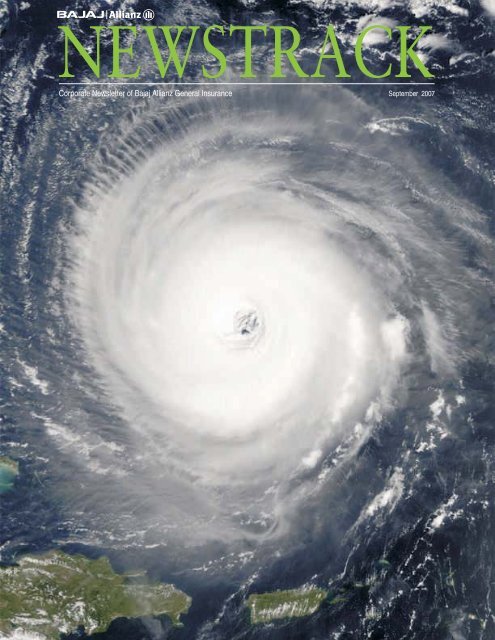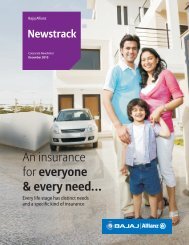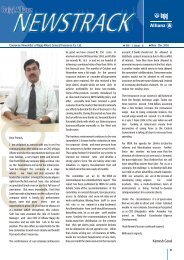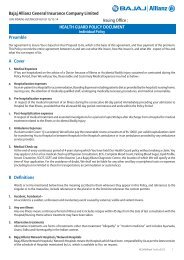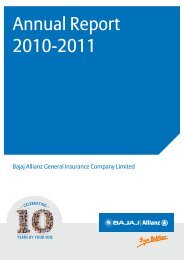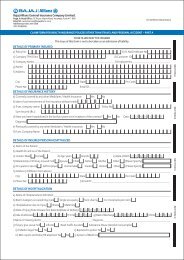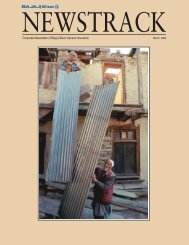Corporate Newsletter of Bajaj Allianz General Insurance
Corporate Newsletter of Bajaj Allianz General Insurance
Corporate Newsletter of Bajaj Allianz General Insurance
You also want an ePaper? Increase the reach of your titles
YUMPU automatically turns print PDFs into web optimized ePapers that Google loves.
NEWSTRACK<strong>Corporate</strong> <strong>Newsletter</strong> <strong>of</strong> <strong>Bajaj</strong> <strong>Allianz</strong> <strong>General</strong> <strong>Insurance</strong> September 2007
Front Cover: Eye <strong>of</strong> a stormHurricane Isabel over Puerto RicoBy - NASA ImageryImage from istockphotoIssue date: September 2007Published by: <strong>Bajaj</strong> <strong>Allianz</strong> <strong>General</strong> <strong>Insurance</strong>Editorial Team:Santosh BalanAjay VarmaPrinted at: Pragati Art Printers, Hyderabad<strong>Bajaj</strong> <strong>Allianz</strong> Newstrack, a quarterly newsmagazine <strong>of</strong><strong>Bajaj</strong> <strong>Allianz</strong> <strong>General</strong> <strong>Insurance</strong> Company Limited,provides current information on the activities <strong>of</strong> <strong>Bajaj</strong><strong>Allianz</strong>, India and its affiliates.For further information on the articles and newsappearing in this magazine please contact SantoshBalan at +91-20-66026603or email santosh.balan@bajajallianz.co.inVisit our website: www.bajajallianz.co.inViews / Information expressed herein are illustrative andinformative in nature and not binding on the company. <strong>Insurance</strong> isthe subject matter <strong>of</strong> solicitation.<strong>Bajaj</strong> <strong>Allianz</strong> <strong>General</strong> <strong>Insurance</strong> Company LimitedGE Plaza, Airport Road, Yerawada, Pune - 411006
Changing <strong>of</strong> the GuardSwaraj Krishnan - CEOGreetings!“ There is nothing permanent, except change”, said Heraclitus, afamous philosopher and author. This prophetic statement holdstrue to what is happening here at <strong>Bajaj</strong> <strong>Allianz</strong> as we now standat the threshold <strong>of</strong> changes. Kamesh takes on the role <strong>of</strong> CountryManager <strong>of</strong> <strong>Allianz</strong> in addition to the responsibility <strong>of</strong> being theCEO <strong>of</strong> <strong>Bajaj</strong> <strong>Allianz</strong> Life <strong>Insurance</strong>, taking over from SamGhosh, who moves to Bahrain as Regional CEO <strong>of</strong> <strong>Allianz</strong>Middle East.Kamesh was involved in setting up the operations from scratchand steering the company’s transition from tariff to de-tariffregime. Kamesh’s contribution has been immense and has madethe company one <strong>of</strong> the leaders in the industry.I look forward to building on this strong foundation <strong>of</strong> open,performance based and innovative practices instituted by Samand Kamesh during their stints in the company. Our best wishesto both <strong>of</strong> them in their new roles.Changes have been happening outside the precincts <strong>of</strong> ourcompany too. In the second phase <strong>of</strong> detariff, pricing barriers areslated to be removed in all lines except Motor Third Party (TP).The industry is moving towards common minimum marketwordings for these lines. Insurers would then be free to tailorpolicies to match the needs <strong>of</strong> the insuring public with add-onsetc. to amend the chassis cover being proposed.So how are we bracing ourselves to the new challenges? In thefollowing pages Tapas Mandal and V. P. Sharma discuss thetrends and impacts <strong>of</strong> discounting in fire and engineering lines,Ajay discusses how we are preparing our employees and channelpartners to face the new de-tariff regime. Rahul and Mihir haveundertaken an extensive mapping exercise<strong>of</strong> flood prone areas and discuss what itmeans for our clients. In some <strong>of</strong> the pastissues <strong>of</strong> Newstrack, we had talked aboutthe importance <strong>of</strong> loss minimizationexercises, this time we spoke with a few <strong>of</strong>our clients to understand their view on thisexercise. Tapan, who had initiated theconcept <strong>of</strong> a satellite <strong>of</strong>fice in various B &C class towns, discusses the trials andtribulations <strong>of</strong> this initiative. Sanjayreveals the various steps taken to tackle themenacing racket <strong>of</strong> frauds in TP claims.Roohi one <strong>of</strong> our ex-management traineestalks about how her stint at <strong>Bajaj</strong> <strong>Allianz</strong>keeps her in good stead in her new role inan engineering consultancy firm in USA.While the industry continued to grow by15% in August, <strong>Bajaj</strong> <strong>Allianz</strong> grew by 33%and the market share grew to 8%. We havedone reasonably well in the last twoquarters. The coming days would be full <strong>of</strong>challenges and unpredictable situations.I wish you all a safe and peaceful festiveseason.swaraj.krishnan@bajajallianz.co.inNewstrack September 2007 3
CONTENTSChanging <strong>of</strong> the GuardBy Swaraj Krishnan, CEO - <strong>Bajaj</strong> <strong>Allianz</strong> <strong>General</strong> <strong>Insurance</strong>Our new CEO's messageFlood MappingRole <strong>of</strong> Flood Mapping in Management <strong>of</strong> <strong>Insurance</strong>By Mihir Vohra and Rahul VisputeFlood mapping plays a crucial role in the management <strong>of</strong> <strong>Insurance</strong>, and we have conductedextensive studies on flood prone areas. A brief introduction <strong>of</strong> the work done thus far.TrainingA Continuous JourneyBy Ajay Dasgupta, Sr Manager, L & D - <strong>Bajaj</strong> <strong>Allianz</strong> <strong>General</strong> insuranceAt <strong>Bajaj</strong> <strong>Allianz</strong>, we are constantly upgrading our skills, Ajay talks about how the L&D departmentkeeps up with constant training <strong>of</strong> our staffDetariffing - Fire and EngineeringTrends and ImpactBy Tapas Mandal and V. P. Sharma - AVPs Underwriting - <strong>Bajaj</strong> <strong>Allianz</strong> <strong>General</strong> <strong>Insurance</strong>Clients' Speak- Loss MinimisationWe have recently carried out loss minimisation studies for our clients. The results have been openlyshared with them and suggestions have been made towards loss minimisation. Interviews with some<strong>of</strong> our clients on their views <strong>of</strong> this studyExtending ReachA Successful ExperimentBy Tapan Singhel - <strong>General</strong> Manager - <strong>Bajaj</strong> <strong>Allianz</strong> <strong>General</strong> <strong>Insurance</strong>ClaimstrackOur regular showcase <strong>of</strong> claims made, claims paid and time taken for settlementsUncovering Third Party FraudCaptain Sanjay Moholkar - VP, Claims - <strong>Bajaj</strong> <strong>Allianz</strong> <strong>General</strong> <strong>Insurance</strong>Strong FoundationA Stepping Stone To SuccessBy Roohi Ahuja - Ex-employee - <strong>Bajaj</strong> <strong>Allianz</strong> <strong>General</strong> <strong>Insurance</strong>International Report - A Great Deal <strong>of</strong> IntoleranceAnother perspective to the Global Warming Debate3568911131416174Newstrack September 2007
Flood MappingRole <strong>of</strong> Flood Mapping in Management <strong>of</strong> <strong>Insurance</strong>Man’s scant respect for the environment has had adevastating impact on the climate <strong>of</strong> our planet.Recurring floods year after year, all over the world, havebrought death and destruction to life and propertyaugured by the Greenhouse effect. The situation in Indiais no better if not worse. Even two years after itsoccurrence, residents <strong>of</strong> Mumbai have vivid memories <strong>of</strong>26/7, when they witnessed the worst floods in the annals<strong>of</strong> the city. The poor infrastructure <strong>of</strong> most <strong>of</strong> our citiesto protect life and property and the regularity in theoccurrence <strong>of</strong> the floods is obviously going to have amajor impact on insurance companies saddled withincreasing claims.This year too the scenario was not different, though theseverity <strong>of</strong> destruction had reduced. Floods have struckall the major cities with a regular frequency. While part<strong>of</strong> the problem can be attributed to poor infrastructurepresent in these cities, it is quite clear that this problemhas to be tackled by all possible means.After the 26/7 event in Mumbai and the subsequentexperience in the following year <strong>Bajaj</strong> <strong>Allianz</strong> realizedthat the event is <strong>of</strong> regular occurrence and floods per se,can no longer be dismissed as a one-<strong>of</strong>f events. We did aflood mapping study in most <strong>of</strong> the flood prone placeslike Mumbai and its nearby areas, Gujarat and AndhraPradesh. The object <strong>of</strong> the study was to:• Understand specific areas where flood andinundation are repeatedly causing damages and thereasons there<strong>of</strong>.• Build enough data to settle claims quickly.• Identify methods <strong>of</strong> loss control and ways to reduceextent <strong>of</strong> damage to business insured.• Create goodwill and awareness among our clientsand to reduce their material and financial loss bysuggesting improvements in their operations.When the team set out to do the mapping, care wastaken that most <strong>of</strong> the industrial areas were included inthe study and the flow pattern <strong>of</strong> rivers, nullahs(sewerage system) or any water bodies in nearby areaswere all taken into account.The mapping was done after numerous visits to thelocation for inspection, using various meteorologicaldata, tracking the risk prone areas and monitoring thedata on a continuous basis. In addition to this variousmapping s<strong>of</strong>tware, world weather reports, global floodregister reports which contained locations flooded,duration <strong>of</strong> flood, cause <strong>of</strong> flood, amount <strong>of</strong> loss,flooded river name, areas affected and severity class, etc.were collated and interpolated for the study. <strong>Bajaj</strong><strong>Allianz</strong> also tied up with various bodies which providenear real time alerts by SMS/Fax/website about naturaldisasters around the world and tools to facilitateresponse co-ordination, including media monitoring,map categories and virtual on-site operations coordinationcentre. Past flood loss history for thatparticular location was also extracted from the claimfiles. Low lying areas were clearly mapped and thelocation’s loss experience was updated. In addition PML(Probable Maximum Loss) for flood was also estimatedfor that location. The risk engineers observations withspecific comments on plinth height, road level and pasthistory <strong>of</strong> loss was considered. Once this was done, theflood exposure was rated on the scale <strong>of</strong> low, moderateand high. Even the commodity that was stored in suchflood prone locations was taken into account to checkthe water susceptibility and the commodity wascategorized as cat 1,2 and 3 depending on usage <strong>of</strong>commodity, industry whether chemical orpharmaceutical and also type <strong>of</strong> storage facility.Newstrack September 20075
Once the mapping was done, the same was shared with our technical team and also our clients. Some <strong>of</strong> therecommendations <strong>of</strong> the study for flood risk improvement measures were to:• Ensure that electrical installations do not come in contact with water.• Switch <strong>of</strong>f electric supply to electrical installations likely to be affected by water. If required ask help frompower distribution company.• Construct barrier walls surrounding your property to prevent ingress <strong>of</strong> flood water.• Check structural stability <strong>of</strong> your structure before monsoon.• If required contact disaster management cell at your location.• Preserve important documents and valuables like bank and insurance papers, health records, jewellery etc.• Store high value goods at a higher level than low value goods.• Store goods on pallet to increase the height.• This study was an important tool to advise our clients and help them to take feasible measures to minimizethe loss due to floods.With inputs from Mihir Vora, Ahmedabad and Rahul Vispute, MumbaiTrainingA Continuous JourneyAjay DasguptaSr. Manager, Learning and Development“ A change would do you good” said Sheryl Crow.The <strong>Insurance</strong> Industry in India today has become quite like Twenty-20cricket. No one really knows what to expect. From January 2007, tariffbarriers have been removed. Detariffing brings with itself several challengesand opportunities to grow the market and business. At this point theinsurance industry has very little time to grapple with these huge changes.What would ideally take a few years to implement is being put into action in afew months. In this article, I will talk about how the Learning andDevelopment team at <strong>Bajaj</strong> <strong>Allianz</strong> <strong>General</strong> <strong>Insurance</strong> is planning to counterthese challenges.Some <strong>of</strong> the challenges that will crop up are:Constant changes in distribution channelsIn a detariffed regime, we will have to explore newer avenues to reach thecustomer. We will have to discover innovative channels <strong>of</strong> distribution tomake our products widely available.Varied channels come with variedchallenges. Channel Management is goingto be a huge issue as some will enhanceeach other while others will compete. Forexample, more exclusive and higherservice distribution will generally entailless intensity and lesser reach. Cost has tobe traded <strong>of</strong>f against speed <strong>of</strong> delivery andintensity.Talent RetentionSome <strong>of</strong> the major challenges also includedeveloping and retaining the workforce inthe organisation.The expanding market demands a largework force. We therefore, will berecruiting on a continuous basis. By the6Newstrack September 2007
end <strong>of</strong> this financial year we expect to reach a staggeringfigure <strong>of</strong> 3,500. Training intermediaries and the entiredistribution force, on the new paradigm will be achallenge. So, how are we going to keep our workforcecommitted and focused?Implications for Learning & DevelopmentWhat has changed is the very nature <strong>of</strong> the game. It’sfaster, more competitive, the margin for error is lesser,and the learning curve is smaller still. What does all thismean to Learning & Development at <strong>Bajaj</strong> <strong>Allianz</strong>?It means:• Building a ‘Value System’ that makes the organisationmore resilient and adaptive in the face <strong>of</strong> changeI-Lead – U-Lead – V-LeadOur values define our behaviour, our personality andwho we are. Through a series <strong>of</strong> focused programs,discussions and brainstorming sessions, the leadership<strong>of</strong> the company, with support from HR L&D, draftedthe <strong>Corporate</strong> Values.The <strong>Corporate</strong> Values are the never changingdefinition <strong>of</strong> who we are and what we stand for as<strong>Bajaj</strong> <strong>Allianz</strong>.The V-Lead WorkshopsOnce the Values were defined, the Value BasedLeadership program – V-Lead was designed to helpTeam Leaders and Sr. Team Leaders explore andimbibe the <strong>Corporate</strong> Values. The aim <strong>of</strong> theworkshop is to transform Team Leaders to ValueBased Leaders.V-Lead workshops are being conducted across Indiaand the feedback for the program has been quiteamazing.Post the V-Lead workshop, Team Leaders willconduct Value Orientation sessions with theirimmediate teams. The idea is that every individualwho is a part <strong>of</strong> the <strong>Bajaj</strong> <strong>Allianz</strong> <strong>General</strong> <strong>Insurance</strong>family should understand and imbibe the <strong>Corporate</strong>Values.• Developing critical Skills and Knowledge that willhelp us remain competitive in the marketSkills Development Programs (eLearning andClassroom Workshops)While Values provide consistency in our behavior,Skills determine our performance. The Skilldevelopment process began with an organization wideSkill Assessment self-test for Team Members.The test helped Team Members understand key Skillsrequired in carrying out their responsibilities and ananalysis <strong>of</strong> their areas <strong>of</strong> Strength, Opportunity andWeakness. Over 1000 Team Members took the onlineself-test and now have personalized Skill Gap reports.Other Initiatives:Marketing Skills Development Program -MSDPMSDP has been designed to help Marketing Staffimprove critical Marketing Skills required in the detarriffedmarket. MSDP is a mix <strong>of</strong> online andclassroom learning programs. While the onlinecourses focus on Product Knowledge and SellingSkills, the two day classroom workshop focuses onbuilding critical skills required to service channelpartners and remain competitive in the de-tariffed era.Over 32 batches <strong>of</strong> MSDP workshops have beenscheduled across India.Certificate in Principles and Practices <strong>of</strong><strong>Insurance</strong> - CPPICPPI is a 3 month program designed to provide indepthpractical knowledge about FundamentalPrinciples <strong>of</strong> <strong>Insurance</strong> and how they apply to thefield <strong>of</strong> general insurance. This program is completelyonline and provides learners the flexibility to studyanytime, anywhere, be it at their workstation orhome.For a large majority <strong>of</strong> our workforce that has had n<strong>of</strong>ormal training in <strong>Insurance</strong>, CPPI provides anopportunity to receive quality learning and training.Finally, I believe that companies that are more agileand can learn faster than others will come outchampions in the de-tariffed market. The T20 WorldCup is ours and the HR L&D team is sure that wewill continue to retain our market position in the newage insurance industry as well.“The illiterate <strong>of</strong> the 21st century will not be those who cannotread and write, but those who cannot learn, unlearn, and relearn”-Alvin T<strong>of</strong>flerNewstrack September 20077
Detariffing FireTrends & ImpactTapas Mandal and V.P.SharmaAVPs Underwritingand EngineeringAdministered pricing and a liberalized marketseemed to be quite a paradox. In order to correctthis anomaly and in keeping with global trends,pricing barriers in fire, engineering, workmencompensation and motor insurance were removedfrom 1st January, 2007. In order to ensure a smoothtransition, a two step process was put in place with alimited pricing freedom but no change in terms andconditions and the second step envisaged full detarifffrom April 2008 onwards.Detariff in fire and engineering insurance triggered afree fall in premium rates as insurers <strong>of</strong>fered discountsto the level <strong>of</strong> 60% - 70% <strong>of</strong> the earlier rates in theinitial few months. The rates were quoted without anyunderwriting discipline. This indiscriminate pricingdid not reflect the basis for removal <strong>of</strong> price barrierswhich was to give a benefit to the insurers and thecustomers. It was hoped that insurers would behaveresponsibly. At this point <strong>of</strong> time the regulator steppedin to rein in the insurers and fixed a ceiling <strong>of</strong> 51.25%reduction in discounts. This curtailment <strong>of</strong>discounting stabilized the market for the time being.Buoyed by the response, full pricing freedom is beingslated from November 2007 onwards subject tochecks and balance formulated by the regulator.As a result <strong>of</strong> the indiscriminate pricing, fire andengineering portfolio shrunk across the industry. Allplayers had a negative growth <strong>of</strong> almost 40% in thisportfolio in the first quarter which constituted nearly20% <strong>of</strong> the total premium collection. To most <strong>of</strong> thecorporate clients, detariff meant just discounts with noor little regard to the risk pr<strong>of</strong>ile.During the course <strong>Bajaj</strong> <strong>Allianz</strong> has been <strong>of</strong>feringdiscounts that range from 25%-30% on a case to casebasis depending on the risk pr<strong>of</strong>ile <strong>of</strong> the customer. Wehave been successful in convincing our clients aboutthe rating factors and the basis <strong>of</strong> arriving at the rate.The rates have been developed after careful analysis <strong>of</strong>the past claims experience in the respective industry.The frequency <strong>of</strong> claims were interpolated withnumber <strong>of</strong> policies, type <strong>of</strong> claim - whether AOGclaims or otherwise and location <strong>of</strong> incurred claims onearned premium. Only those industries wereconsidered where more than 100 policies had beenissued in that particular class <strong>of</strong> industry. Storm,Tempest, Flood and Inundation (STFI) exposure wasstudied separately to consider impact <strong>of</strong> AOG perilsexposure.This analysis gave us a vital yardstick on the lossbehaviour in that particular industry and provided ameans to arrive at the optimum premium for thatparticular industry.Most <strong>of</strong> the clients agreed to this without any rancour.However we have had to forego some clients whosought discounts that did not match their risk pr<strong>of</strong>ile.We have also taken steps to brace ourselves inthe fully de-tariff scenario by:• Training <strong>of</strong> employees andintermediaries to understand the prosand cons <strong>of</strong> detariff.• Focusing on other lines <strong>of</strong> businesswhere the effect <strong>of</strong> price war is less,like aviation, project insurance, etc.• Cherry picking the business i.e.selection <strong>of</strong> risks by instillingunderwriting discipline.• Changing the portfolio mix withaccentuated focus on retail segmentto compensate for the shrinkingportfolio <strong>of</strong> fire and engineering.tapas.mandal@bajajallianz.co.in and v.sharma@bajajallianz.co.in8Newstrack September 2007
Clients' SpeakLoss MinimisationLoss minimisation is increasingly becoming important not only for the client but also for the insurer. Several lossminimisation initiatives by <strong>Bajaj</strong> <strong>Allianz</strong> <strong>General</strong> <strong>Insurance</strong> have been discussed in some <strong>of</strong> our previous issues. Inthis issue we talk to some <strong>of</strong> our clients to understand their response to the loss minimization studies we haveundertaken for them.Tab India GraniteQ1.Tab India Granites, headquartered in Jaipuris the largest integrated natural stonemanufacturer in India. Tab India is 100%Export Oriented Unit (EOU) with aworldwide clientele and has productionunits at Jaipur and Hosur in Karnataka. TabIndia has won several export awards and isa government recognised Export House.<strong>Bajaj</strong> <strong>Allianz</strong> manages their entireinsurance portfolio <strong>of</strong> fire and marineincluding transit. Sumit Gupta MD shareshis views on our loss minimisation initiative.A 1. We appreciate the efforts made by <strong>Bajaj</strong> <strong>Allianz</strong> inrespect <strong>of</strong> loss minimisation case study made at ourplant. Efforts were made to look into all the possibleangles, which may cause material damages. Not onlywas that area <strong>of</strong> the damage photographed but it wasillustrated during the presentation exhaustively. In myopinion this a good effort made by the company in lossminimisationQ2.<strong>Bajaj</strong> <strong>Allianz</strong> had undertaken loss minimisationprogram in your company. Did you find this initiative<strong>of</strong> any benefit to your company?Were the suggestions on minimising the lossesimplemented in your company?A 2. We are constantly improving our packing standards butin addition to that we have provided nail guns to theworkers so that improper nailing is totally avoided.Workers have been sensitized on the need for properpackaging, the quality <strong>of</strong> inward packaging materialslike wood, nails etc. are monitored and theresponsibilities fixed on the managers and theirinspection report made mandatory. "Hygrometers"have been provided to the workers to check theQ3.moisture content on the wood so that right quality <strong>of</strong>wood is used in packaging. Although fumigation is aregular process in our packing it is now also beingdone at the factory to avoid fungus formation onwood. We have started providing additionalhorizontal supports for the crates as suggested byyour risk management team.A 3. We are sure that after implementation <strong>of</strong> all theabove safety parameters, we will be able to deliverloss free consignments to our customers.Q4.A 4. In my opinion it is the right step in loss minimisation.A loss is felt equally by us as it is felt by an insurancecompany. Our products are mostly used in differentstages <strong>of</strong> construction and in case <strong>of</strong> loss to materialin transit it is quite obvious that the requiredquantity will fall short. This will disturb the entireconstruction schedule and the entire productionplanning to bridge the shortfall. If not done, we maylose customers which eventually is a greater loss.Q5A 5. I feel that your team should keep us updated aboutthe new techniques in packaging standards for stonematerials.Q6.After implementing the suggestions did you noticeany improvements in your system?Any particular aspect that you would like toemphasize that came out conclusively as a result <strong>of</strong>the study?What are the other operational areas that you wouldlike to be included in the study in the future?How can we as your insurer help in minimising yourlosses in other insurance portfolio?A 6.Your risk management team can always update usfrom the loss experiences coming across from otherrelated industries so that preventive measures can beadopted.Samtel Colour Ltd.Samtel Colour Limited, part <strong>of</strong> Samtel Group,manufactures picture tubes, colour electron guns,deflection yoke devices and glass parts. They haveproduction units at Kota, Ghaziabad, Noida andParwanoo. <strong>Bajaj</strong> <strong>Allianz</strong> manages their fire, marine andmotor portfolio. We spoke with Ajay Sehgal, DGM(Finance, Taxation and <strong>Insurance</strong>) about our lossminimisation study.Q1.<strong>Bajaj</strong> <strong>Allianz</strong> had undertaken LossMinimisation program in your company.Did you find the initiative <strong>of</strong> benefit toyour company?A 1. Benefit will be to both the parties. If wehave fewer claims, we can look for areduction in rates. Also you will presentlogical and time-tested techniques, whichwill be a value addition to our company.Newstrack September 20079
Q2. Would you like to give any suggestions?A 2. International experts should conduct the study so thattheir reports are accepted worldwide. Ourinternational vendors should also accept the reports.Packaging used for the transit <strong>of</strong> goods to thecustomer’s should be studied.Q5material in the Godowns or in the open areas. Howshould the goods be covered? What should be theheight <strong>of</strong> the stack? Should we continue to use theexisting forklifts and stackers?How can we as your Insurer help in minimising yourlosses in other insurance portfolio?Q3A 3. The study should be conducted about the alternatesources <strong>of</strong> packaging. Today we are using thermocolthat is a use and throw product. You can suggestsomething which can be used for sometime before ithas to be discarded.Q4.Any particular aspect that you would like to bestudied?What are the other operational areas that you wouldlike to be included in the study in the future?A 5. Thermography should be conduced to see if theelectric fittings are over burdened, or if there is anytension in a particular electronic gadget.Q6. Have you yourself taken any initiatives?A 6. Safety audits are conducted on a regular basis. We asa company follow 5 S. We have already implementedthe new safety guidelines given by ISO. We have ateam <strong>of</strong> trained people and fire fighters.A 4. Study should be conducted for proper storage <strong>of</strong>Solvay PharmaSolvay Pharma India limited,headquartered in Mumbai has apresence in three therapeuticsectors viz. Womens' Health,Gastroenterology and mentalhealthcare. <strong>Bajaj</strong> <strong>Allianz</strong> managestheir entire insurance portfolio. Wespoke with V. K. Sharma, GM(Commercial), Solvay PharmaLimited and asked him for hisviews on our loss minimisationprogram.Q1.A 1. Yes, certainly. <strong>Bajaj</strong> did a detail and rational analysisand brought out some interesting facets <strong>of</strong> our claimhistoryQ2.<strong>Bajaj</strong> <strong>Allianz</strong> had undertaken loss minimisationprogram in your company. Did you find this initiative<strong>of</strong> any benefit to your company?Were the suggestions on minimising the lossesimplemented in your company?A 2. We plan to soon conduct a feasibility study for each <strong>of</strong>the suggestions and hope to proceed with the acceptedones thereafter.A 3. <strong>Bajaj</strong> <strong>Allianz</strong>'s presentation is being shared with thetop management as also the relevant functionalheads. We'll take a final decision on each proposal.Q4.A 4. We need to look at packaging improvementpossibilities for two <strong>of</strong> our products.We need to examine the business on certain routes(including the transporters used) and by furtherstrengthening the compliance at C&F centres withoperating procedures (stacking, etc.)Going forward, we - as a responsible company - needto carefully analyse our claims from variousperspectives (as done by <strong>Bajaj</strong>), on a continuousbasis.Q5A 5. We plan to work on the present findings first andensure a good improvement before deciding on this.Q6.Any particular aspect that you would like toemphasise that came out conclusively as a result <strong>of</strong>the study?What are the other operational areas that you wouldlike to be included in the study in the future?How can we as your insurer help in minimising yourlosses in other insurance portfolio?Q3What are the steps taken to implement the suggestionsin your company?A 6. We do not have any major claims in any othercategory.10Newstrack September 2007
Extending Reach-A successful experimentTapan Singhel<strong>General</strong> Manager - <strong>Bajaj</strong> <strong>Allianz</strong> <strong>General</strong> <strong>Insurance</strong>he insurance market haschanged over the years andhas grown beyond the metros tomini metros including B and C classtowns, which are emerging as newgrowth centres.Earlier non-life insurance was mostly addressing thecorporate sector which is more insurance savvy to protecttheir bottom line and there was very little emphasis to tapthe retail segment – the consumers. Motor insurance wasthe only product that was targeted at this segment.Health insurance in the form <strong>of</strong> hospital reimbursementscheme was the next big portfolio which targeted thissegment.With the surge in middle class population, increase invehicle sales and lifestyle changes, the retail segmentsuddenly changed gears and hit the growth path. Theentry <strong>of</strong> private players has refocused the attention <strong>of</strong> thiskey segment. The other attractions towards this marketwere –• Virgin marketT• Increase in disposable income• Change in lifestyle <strong>of</strong> rural India• Media created a lot <strong>of</strong> awareness amongst suburbanand rural India• Lack <strong>of</strong> intense competition which is witnessed inmetro and mini metroBesides the above, with the advent <strong>of</strong> free pricing regime,the focus on retail segment was accentuated. Naturallyone had to fall back on these untapped markets with arenewed vigor. Fortunately <strong>Bajaj</strong> <strong>Allianz</strong> had initiated thison an experimental basis as early as 2003 and thelearning had helped us scale up at a much faster pace.How do you reach them?Reaching the diverse and scattered consumers <strong>of</strong> the retailsegment was <strong>of</strong>ten difficult if not impossible for us. In theearly days <strong>of</strong> our inception, we started with setting up<strong>of</strong>fices in metros and mini-metros. So we had regional<strong>of</strong>fices and area <strong>of</strong>fices to keep a tab on this segment.However we found that though this strategy worked, wewere missing a larger share <strong>of</strong> the pie from these emerginggrowth centres.Initially we started approaching the customers at theselocations from our hub, but it did not work out for thereason that the insured always wants the insurer to beclose to him/her and in constant personal touch withthem. Moreover we did not have a mechanism to issueany document on receipt <strong>of</strong> premium. This was notacceptable to the customers at these locations.There was a risk in exploring these emerging growthcentres, but since we are in the risk business, we took acalculated risk. Initially we had a customer representativein some <strong>of</strong> these centres to gauge, develop and thenconsolidate the market. Some <strong>of</strong> the customerrepresentatives were not able to do more than justestablishing a rapport with the existing relationships. Butthey were able to at least create awareness about ourcompany and also give us an idea about the market sizeand potential.This feedback and their performance encouraged us todevelop what was to be called a satellite <strong>of</strong>fice which wasattached to a hub which was an area / regional <strong>of</strong>fice. Thesatellite <strong>of</strong>fice was responsible for premium collection,developing distribution channels, besides initiating localtie-ups with motor dealers, and urban or rural coopertaivebanks. The claims and accounting was handledby the nearest area or regional <strong>of</strong>fice to which it wasattached.This experiment initiated in 2003 has become successfuland today we have around 70-80 <strong>of</strong>fices in these growthcentres. Most <strong>of</strong> the area / regional <strong>of</strong>fices now haveseveral satellite <strong>of</strong>fices orbiting around it and has given usthe much needed impetus in growth and penetration. Thecontribution from these satellite <strong>of</strong>fices is nearly 9% <strong>of</strong>the total premium. Efforts are on to increase this to atleast 15%.What were the challenges?We faced many challenges once we embarked on this planto open satellite <strong>of</strong>fices :•Finding a suitable candidate as there was reluctanceto move to up country locations.Newstrack September 200711
• Having a lean but effective structure.• Finding a suitable place to start operations.•• Policy issuance and issuing receipts.•Delegation <strong>of</strong> authority guidelines for the satellite<strong>of</strong>fices.Taking care <strong>of</strong> petty <strong>of</strong>fice expenses without a bankaccount.• How to meet the training requirement.• Internet connectivity without an <strong>of</strong>fice.The challenges were immense and so were the solutions.For most <strong>of</strong> the satellite <strong>of</strong>fice heads, it was a trial anderror method to resolve their day-to-day operationalproblems. Almost all the staff started their <strong>of</strong>fice in a car,armed with a cell phone as <strong>of</strong>fice space was the majorconstraint. Some <strong>of</strong> them started operating from theirresidence, others used more ingenious methods.In Vijaywada, soon after a tie-up with the leading <strong>Bajaj</strong>Auto dealer, the showroom was encroached in the name<strong>of</strong> providing training to the dealer staff in issuing policiesfor the 2-wheelers they sold! Slowly almost nine members<strong>of</strong> the Vijaywada satellite <strong>of</strong>fice occupied the space andstarted operating from their location. “We could do thispurely because <strong>of</strong> the rapport that we had with thedealer”, said Shyam Sunder, <strong>of</strong>fice head <strong>of</strong> Vijaywada.Some others armed with a laptop and cell phone werelucky to grab a corner in a <strong>Bajaj</strong> <strong>Allianz</strong> Life <strong>of</strong>fice andrun the operations from there. Other ingenious ones usedthe agency’s or intermediary’s <strong>of</strong>fices to do their routinework.Most <strong>of</strong> them carried a kit which had documents likeletter heads, envelopes, insurance stamps, company seal,etc. in their own vehicles. Pradeep <strong>of</strong> Calicut <strong>of</strong>fice whostarted as a Customer Service Representative (CSR),explained their typical daily work schedule, “Our daywould begin with visits to the bank to deposit thecash/cheque collected the previous day, then a visit tomotor dealers to service their requirements or forge tieupswith new intermediaries or interview prospectiveagents to build an agency channel. The second half <strong>of</strong> theday would be at the agency <strong>of</strong>fices or at the cyber cafe,where we scanned the documents and send it to our Kochi<strong>of</strong>fice for policy issuance. The evenings would be at thecourier <strong>of</strong>fice to prepare and dispatch the originalproposal forms and other requests.” Looking at theirschedule, most <strong>of</strong> the time, you would find themensconced in other’s <strong>of</strong>fices or cyber cafes.Some <strong>of</strong> the other challenges besides <strong>of</strong>fice space wasconnectivity and problems in accounting and issuingreceipts for the premium collected. The other was theback <strong>of</strong>fice to issue policies, which became serious as thevolumes increased. But then when the business done bythe CSR attained critical mass, they were automaticallyupgraded to the next level and provided with additionalstaff and <strong>of</strong>fice spaceWhat drives them?Well amidst all the challenges and the uncertainties, whatis it that drives these people to explore in to theseuncharted territories. One <strong>of</strong> them succinctly puts it as –“Career growth and the mere challenge to create a marketfrom zero”. Yes, most <strong>of</strong> them were in their mid-20s tookthe gauntlet and charted out a growth strategy forthemselves and the company.Opening each satellite <strong>of</strong>fice was a unique challenge initself and a great learning for all <strong>of</strong> us. We are happy thatwe were able to open a large number <strong>of</strong> satellite <strong>of</strong>ficeswhich are performing reasonably well and are growingconsistently.LearningsWhile the spirit <strong>of</strong> adventure and entrepreneurial skillswere the driving force for these young people to board thesatellite <strong>of</strong>fice bandwagon, there was couple <strong>of</strong> importantlearnings from this exercise. One <strong>of</strong> the key learning is todevelop a manual for such operations. This manual is togive a process to the whole exercise and ease the burden<strong>of</strong> the new challengers so that there is no longer a trialand error method. This will help them to quickly replicatethe success <strong>of</strong> the other locations.Most <strong>of</strong> the satellite <strong>of</strong>fices started with one to twopersons and have now grown to over 25 people.tapan.singhel@bajajallianz.co.in12 Newstrack September 2007
CLAIMSTRACKNewstrack September 200713
Uncovering Third Party FraudCapt. Sanjay MoholkarVP ClaimsFrauds in Third Party (TP) claims have been increasingday by day. Such rackets are active in almost all parts <strong>of</strong>the country. The people involved in the racket are usinginnovative methods for claiming under the provisions <strong>of</strong>Motor Vehicle Act, which in legal parlance is called associal beneficial legislation for the victims <strong>of</strong> RoadTraffic Accident (RTA). This is a serious crime <strong>of</strong>tencommitted by the white collared people wherein theymake a fortune out <strong>of</strong> somebody else’s misfortune.Technological developments are being put to such awrong usage that at times, it forces one to think -whether it is a boon or curse?Insurers need to be more innovative to bring thesefrauds to the notice <strong>of</strong> all concerned, then only will it bepossible to defend them and avoid the drain on publicfunds.Some common type <strong>of</strong> frauds in TP Claims observedover the years are –• Fake FIR.• Fake Driving License, Bogus endorsements onDriving licenses.• Fake/Fabricated/Inflated Medical Bills.• Change/Replacing <strong>of</strong> Driver, or same driverinvolved in multiple accidents.• Natural deaths converted to accidental death onroad due to vehicle hits.• Non-Traffic Accident converted into Road TrafficAccident (RTA), Suicidal cases or natural deathcases shown as accidental deaths, Adding entries inMLCs or police papers for persons not involved inaccident.• Change/replacing <strong>of</strong> Vehicle, Showing involvement<strong>of</strong> vehicles having insurance or addition <strong>of</strong> vehiclesin Hit and Run cases.• Two cases filed for the same person.• Fake/Fabricated Cover Note or Policy.• Passengers <strong>of</strong> Goods Vehicle shown as pedestrians,or unauthorized passengers in goods vehicle shownas owner <strong>of</strong> goods.The racket <strong>of</strong>ten includes the claimant, claimant’sadvocate, hospitals, doctors, owners <strong>of</strong> vehicles andeven the police are equally involved in the fraud /fabricated cases as it would be difficult to get awaywithout their help. Sometime they manage to make acase in such manner that it becomes so perfect that theiridentity <strong>of</strong>ten remains undisclosed.We at <strong>Bajaj</strong> <strong>Allianz</strong> take these frauds seriously as theyare not only vitiating the society but also putting thepolicyholders’ money at risk. Our endeavour fordefending such cases before courts or tribunals is tobring it to their notice that such frauds if allowed to becontinued are a drain <strong>of</strong> public money which ultimatelyresults in increase in cost <strong>of</strong> third party premium due toincreased pay outs for such claims.When a TP claim is received at our <strong>of</strong>fice, we follow thesteps below :• Carefully scrutinize the claim petition, investigationreport, police papers, medical documents and allother relevant documents .• If we suspect that there is something unusual we diginto the matter to know the real facts <strong>of</strong> the case.• If required we reinvestigate the matter on specificissues and ask the investigator to bring on recordcertain documents which are necessary todistinguish the fake one.14Newstrack September 2007
• When there is a suspicion, we check the Claimantsdocuments with the certified copies brought onrecord by the investigator to verify if there is anymanipulations or not.• On a thorough investigation at the time <strong>of</strong> TPClaims, if it is revealed that the story given in theclaim form is not correct or the driver is changedfor the sake <strong>of</strong> claim or insured has suppressedmaterial facts, a legal notice is sent to the insuredfor manipulation / cheating and we ask him to payback the settled amount.• At times we also put pressure <strong>of</strong> filing a criminalcomplaint and most <strong>of</strong> the times they relent andwithdraw the claim if it is a fake one.• Considering the competition in the market andrules framed by the authorities we have to settle‘Own Damage Claim’ within certain period <strong>of</strong>time. We assess the loss, check the story given bythe Insured in the claim form and use it to settle theclaim after getting certain clarification if required.1. Ghost Car in Kolkata – Here a fictitious car is usedto dupe the insurance industry and the amount s<strong>of</strong>ar disbursed is over Rs.1 crore.2. Fake FIR scam in Salem.3. Strict abidance <strong>of</strong> provisions <strong>of</strong> Section 158 (6) <strong>of</strong>MV Act by all concerned like police authoritiesshould inform the insurer and the nearest tribunalabout the RTA victims.4. We have agreed to share the additional cost <strong>of</strong>investigations through CB_CID Forum establishedfor reinvestigating such fraud matters as they haveexpressed reservations for doing this work due toshortage <strong>of</strong> funds for <strong>of</strong>fice infrastructure andadditional costs involved.We also involve advocates by holding seminars or meetsand thereby explaining the nuances <strong>of</strong> TP claims andrelated frauds.• We have been successful in getting back money paidtowards Own Damage claim <strong>of</strong> vehicles in manycases where it was found that insured hasmisrepresented the facts about name <strong>of</strong> the driverby showing fear <strong>of</strong> criminal complaint and in fewcases money has been recovered even after lapse <strong>of</strong>more than an year when things were revealed at thetime <strong>of</strong> lodging <strong>of</strong> TP claim.• On intimation we appoint an investigator withspecific instruction to investigate the matter and ifan investigation <strong>of</strong> Hospital Records (admissioncard, wound certificate, case papers etc.) revealsthat a non-traffic accident was converted into RoadTraffic Accident or the rider <strong>of</strong> the vehicle wasshown as pillion rider etc. we take proper plea,produce proper documentary evidence and call theproper witness before the court to prove our case.In few cases the court has dismissed the case andgiven liberty to us for filing criminal complaintagainst the culprits.The defense and line <strong>of</strong> action in most <strong>of</strong> the casesdepends upon the facts and circumstances <strong>of</strong> each case.There are instances where we have along with otherinsurance companies jointly filed complaints andinitiated action to check the menace <strong>of</strong> fraud .Some <strong>of</strong> the following cases have the entire industryfighting against fraud:Newstrack September 200715
Strong FoundationA Stepping Stone to SuccessRoohi AhujaEx-employee - <strong>Bajaj</strong> <strong>Allianz</strong> <strong>General</strong> <strong>Insurance</strong>It has been a year and a half since I left <strong>Bajaj</strong> <strong>Allianz</strong> <strong>General</strong>insurance, corporate marketing, Delhi RO and came to USA. Ayear ago, I started working as an Account Manager with anengineering consultancy firm providing networking solutionsto cellular carriers like Verizon Wireless, AT&T, Sprint Nexteletc. This has been a completely different sector; a highlytechnical field, an entirely different market and workenvironment. My work involves building relationships withclients, procuring new projects and ensuring timely completion<strong>of</strong> projects within defined time lines. I assumed the role <strong>of</strong> amanager with the responsibility <strong>of</strong> a team <strong>of</strong> technical staffand defining the projects terms to ensure the projects get donein a cost-effective manner.I joined <strong>Bajaj</strong> <strong>Allianz</strong> back in July 2003 as a managementtrainee, when the sector was very nascent, just privatised andstill dominated and reigned by insurance gurus and veteransfrom public sector companies. <strong>Bajaj</strong> <strong>Allianz</strong>, true to its spirit <strong>of</strong>experimenting was one <strong>of</strong> the first private insurers toencourage a new breed in this sector. A breed <strong>of</strong> non-domain,young, fresh graduates who didn’t know what insurancemeant!<strong>Bajaj</strong> <strong>Allianz</strong> <strong>General</strong> <strong>Insurance</strong>, a company which had 300employees in 02-03, grew to have 1200, four times the size in amatter <strong>of</strong> 3 years, a company which had Rs. 300 crorepremium in 02-03 became a Rs. 1000 crore company in 3years, a company which had “Who we are” as a slide in theircorporate presentation started selling itself as a brand in 3years time. For me the best part <strong>of</strong> all this was that I was apart <strong>of</strong> this growth and I feel proud at having contributed tothis accelerated pace <strong>of</strong> growth!The management trainee batch, 20 fresh graduates from B-School underwent an extensive training to understand thedynamics <strong>of</strong> insurance and market scenario. We had expertsand top management keenly participating in our developmentand understanding before we were sent out to differentlocations. The training encompassed class room lectures, reallive case-studies, role-plays, behavioral lectures and <strong>of</strong>f-sitetraining. In-all it was a great experience which set the pace forthe years to come.I spent my next 3 years in the company working in one <strong>of</strong> thebiggest markets <strong>of</strong> India: Delhi RO, an <strong>of</strong>fice that had a pulse<strong>of</strong> its own, an <strong>of</strong>fice that taught you “don’t find faults, findremedies”. At that time, things were shaping up for the entireindustry; privatisation in the sector was still a novel conceptand was not readily accepted by the customers and thechannel. But it was sheer grit and resilience <strong>of</strong> the companyand its employees which turned the tables and took thecompany to new heights. From being a centralisedorganisation, <strong>Bajaj</strong> <strong>Allianz</strong> became a completely decentralisedone in order to reduce the TAT to serve the customers betterand effectively. If you had an idea, you had the capability; youcould implement the same the very next day - that was thekind <strong>of</strong> independence all the employees enjoyed. The Companybelieved in delegation and in a flat hierarchy, both in letter andspirit. This helped all <strong>of</strong> us to grow rapidly without anystumbling blocks and unnecessary delays!Today I feel motivated to write this because it has been a greatexperience to be associated with this organisation from thestart, seeing it react and adapt to the market dynamics rapidly,becoming a leader in its domain in a short span <strong>of</strong> time. Iworked with corporate marketing group as Assistant Managerwith the responsibility <strong>of</strong> not only generation <strong>of</strong> premium andsales but also looking at the business as a whole in terms <strong>of</strong>pr<strong>of</strong>itability, claim experience and complete insuranceportfolio. This approach <strong>of</strong> looking at the portfolio from allaspects on insurance rather than just premium is encouragedat all levels <strong>of</strong> employees. I learned so much about MIS in thisorganisation <strong>of</strong> making reports <strong>of</strong> business done, pr<strong>of</strong>itabilityreport, budgeting for the team, target setting for the year.Having been an integral part <strong>of</strong> a hugely successful tenure with<strong>Bajaj</strong> <strong>Allianz</strong> has given me the confidence and the ability andto carve out a similar future in my current engagement.I have come to realise how much I have grown and learned totake responsibilities, make decisions, manage a team, providesolutions to problems faced and find a way out <strong>of</strong> situations. Igreatly attribute my learning and my performance todaybecause <strong>of</strong> a strong training foundation with <strong>Bajaj</strong> <strong>Allianz</strong>!<strong>Bajaj</strong> <strong>Allianz</strong> has been the ideal training ground, a steppingstonefor a great career in future. I have deeply imbibed thephilosophy <strong>of</strong> my parent organisation that “Knowledge has tobe improved, challenged, and increased constantly, or itvanishes”.“Before everything else, getting ready is the secret <strong>of</strong> success”– Henry Ford16 Newstrack September 2007
This article is reprinted with permission from <strong>Allianz</strong> Journal - 2/2007Newstrack September 200717
18Newstrack September 2007
Newstrack September 2007 19
EventsLaunch <strong>of</strong> JKB Home SecureH. A. Drabu, Chairman and CEO <strong>of</strong> J & KBank in the presence <strong>of</strong> Kamesh Goyallaunched a co-branded product – JKB HomeSecure on 24th August 07. This product -JKB Home Secure is a customized productdeveloped exclusively for the bank customerskeeping in mind the needs <strong>of</strong> people inJammu & Kashmir. The product coversearthquake and also covers the householdcontents on a first loss basis which takes care<strong>of</strong> underinsurance. With the three planoptions, the customers also get the variety tochoose what suits their needs best at theright cost. J&KBankhasabancassurancetie-up with <strong>Bajaj</strong> Allainz since 2002.<strong>Allianz</strong> Capital Markets DayKamesh Goyal was invited at the <strong>Allianz</strong>headquarters to share the success story <strong>of</strong><strong>Bajaj</strong> <strong>Allianz</strong> companies at the annualanalysts meet in Germany. The analysts meetcalled <strong>Allianz</strong> Capital Markets Day held by<strong>Allianz</strong> annually where some <strong>of</strong> the topanalysts in Europe assemble. This year it washeld on 11th July at Frankfurt.


